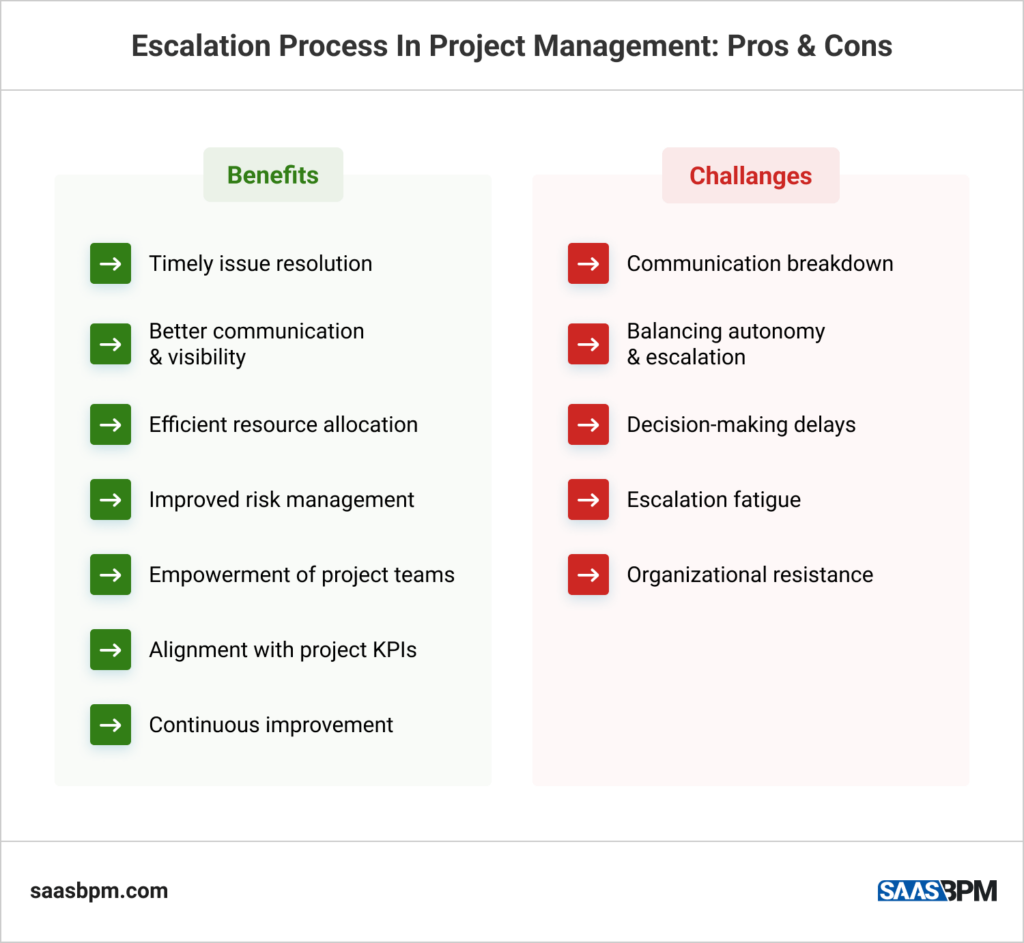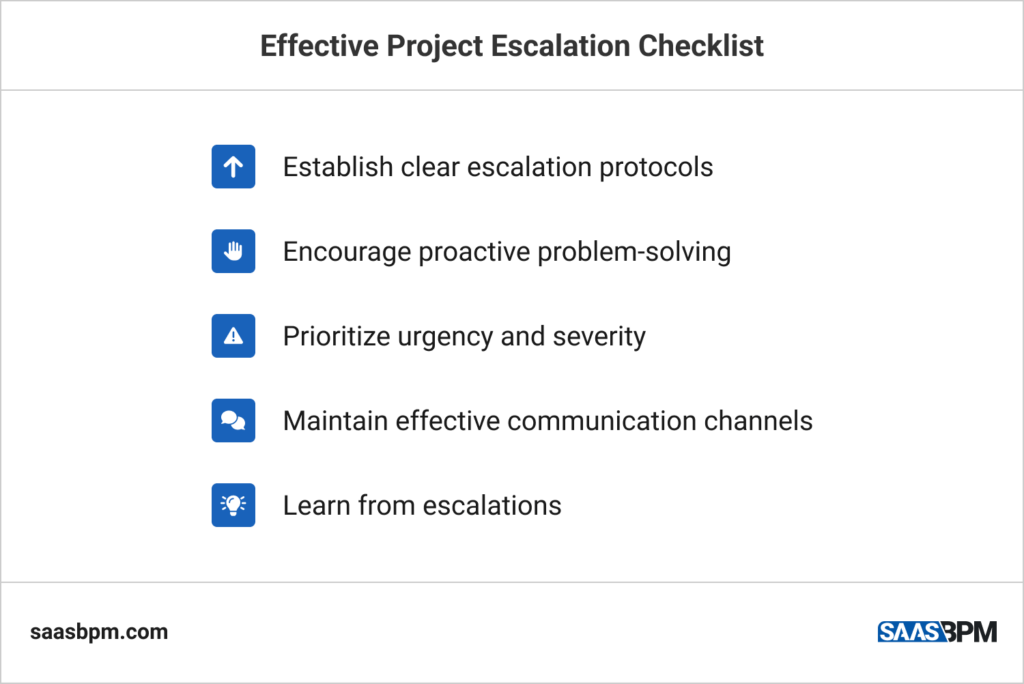The escalation process in project management is when stakeholders discuss the current state of a project, as well as necessary changes in business operations, and effectively plan for potential risks that may occur. As it sounds, it is very important for the successful execution of the overall project as, if handled properly, it can even out all possible challenges and map out timely solutions.
Imagine if you start a project without thinking about risks – it is like going in the wilderness empty-handed! Therefore, project managers should always spend a good amount of time on risk mitigation and discuss challenges that can be prevented during the duration of the task at hand.
In this article, we will explain what project escalation is, its pros and cons, and also, X best practices for managing the process effectively.
What Is Project Escalation?
Project escalation refers to the process of communicating project issues or concerns to higher levels of management or authority within an organization. It serves as a mechanism to address and resolve problems that cannot be effectively handled at lower levels of the company hierarchy.
Typically, a project management escalation process occurs when there is a significant impact on important objectives, such as schedule delays, cost overruns, resource constraints, or quality issues.
During the project escalation, project managers first identify and evaluate the severity and urgency of the problem. They then determine the appropriate level of urgency based on the project’s organizational structure and authority matrix. This may involve referring to a project sponsor, steering committee, senior management, or other relevant stakeholders who possess the necessary decision-making authority and resources to address the problem.
Benefits of Project Escalation

The escalation process in project management plays a vital role in ensuring the smooth execution and successful delivery of key deliverables. Here are some of the main benefits of implementing an effective escalation process:
Timely issue resolution
Escalation allows project managers to seek assistance from higher levels of authority when facing complex or critical issues. By involving individuals with greater decision-making power, problems can be resolved in a more timely manner, preventing potential delays or setbacks.
Enhanced communication and visibility
The escalation process fosters open communication channels between project teams and higher management levels. This improves transparency, as issues are brought to the attention of those responsible for making strategic decisions. It also provides visibility into potential risks and challenges that may affect project outcomes.
Efficient resource allocation
The project escalation process ensures that the necessary resources, such as additional funding, personnel, or technical expertise, are allocated promptly to address project issues. This helps reduce the impact of problems on timelines and overall success.
Improved risk management
The escalation process allows project managers to foresee risks that have the potential to significantly impact project objectives. By bringing possible issues to the attention of higher-level stakeholders, they can build appropriate mitigation strategies and prevent any emergencies from happening.
Empowerment of project teams
The escalation process empowers project teams by providing them with a mechanism to raise issues that are beyond their immediate control. It demonstrates that their concerns matter and that there is a support system in place to address critical challenges. This empowerment boosts morale and motivates team members to take ownership of their responsibilities.
Alignment with project goals and objectives
The escalation process ensures that project issues are evaluated and addressed in alignment with the project’s goals and objectives. By involving higher-level stakeholders, decisions are made with a broader perspective, considering the overall project impact. This alignment helps in maintaining focus and prioritizing efforts towards the successful achievement of project objectives.
Continuous improvement and lessons learned
The escalation process in project management provides opportunities for continuous improvement and learning. By analyzing escalated issues, managers can identify patterns, root causes, and recurring problems. This analysis helps in refining business processes, updating risk management strategies, and enhancing decision-making in future projects. Lessons learned from escalations contribute to organizational knowledge and promote a culture of ongoing improvement.
Challenges of the Escalation Process in Project Management
While project escalation offers numerous benefits, like any process, it also presents its own set of challenges. Here are some considerations to keep in mind:
Communication breakdown. Poor communication can hinder the effectiveness of the escalation process. Project managers need to ensure that communication channels are clear, consistent, and readily accessible. Miscommunication or lack of timely information can lead to delays in issue resolution and misalignment between project teams and higher management levels.
Decision-making delays. Escalating issues to higher levels of authority may introduce delays in decision-making. This can occur if the appropriate stakeholders are not readily available or if they lack the necessary information. Therefore, project managers must work closely with them to streamline the decision-making process and ensure that necessary approvals or actions are expedited.
Escalation fatigue. Continuous discussion of issues can lead to escalation fatigue among project teams and stakeholders. This occurs when problems are consistently covered without sufficient resolution or follow-up. Escalation should be used judiciously to address critical issues, while empowering project teams to handle routine challenges at their level.
Organizational resistance. Some organizations may exhibit resistance to the escalation process due to cultural or political factors. In such cases, individuals may be hesitant to talk about issues for fear of blame or reprisal. Overcoming this challenge requires a culture of trust, transparency, and accountability, where the escalation process is viewed as a means to collectively address problems and improve project outcomes.
Balancing autonomy and escalation. Project managers must strike a delicate balance between empowering project teams to resolve issues autonomously and knowing when to intervene. Encouraging proactive problem-solving at lower levels while providing guidelines is crucial. Overreliance on escalation can hinder team autonomy and stifle individual growth and decision-making capabilities.
Best Practices for Managing Project Escalations
To help you optimize the benefits of project escalation and mitigate its potential downsides, we’ve lined up 5 strategies that will help you succeed:

- Establish clear escalation protocols. Communicate a comprehensive escalation process that outlines the levels of authority and responsibility for each escalation point. Ensure that project team members understand when and how to raise issues appropriately.
- Encourage proactive problem-solving. Foster a culture of proactive problem-solving within your employees. Motivate project team members to address issues at the appropriate level whenever possible, without unnecessarily escalating them. This empowers individuals to take ownership and find solutions collaboratively.
- Prioritize urgency and severity. When deciding whether to escalate an issue, carefully assess its urgency and severity. Focus on issues that have a significant impact on project objectives, stakeholder expectations, or critical milestones. This helps in prioritizing and addressing the problems that have the biggest impact first.
- Maintain effective communication channels. Establish clear communication channels within the project team and across different levels of management. This ensures that information flows smoothly, allowing for timely and accurate updates on project status, issues, and escalations.
- Learn from escalations. Encourage a culture of learning from project escalations. Conduct post-escalation reviews to identify root causes, patterns, and opportunities for improvement. Use these insights to refine processes and prevent similar issues in future projects.
Conclusion
Project escalation is a valuable process that allows project managers to navigate and resolve complex challenges effectively. Also, it helps all stakeholders understand the progress and what needs to be done to enhance results. So, don’t hesitate to encourage your team members to escalate issues they spot right away – this way you can ensure you will meet the key milestones of the project, and keep your clients happy.

